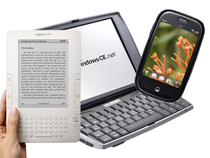 Earlier this year, Paolo Gargini gave the keynote at DesignCon. He is an Intel fellow and director of technology strategy for their manufacturing group. He discussed three market enablers that would drive innovation and new products. He wasn’t being particularly Intel-centric but rather looking at the industry, since this was a keynote. Those three drivers were:
Earlier this year, Paolo Gargini gave the keynote at DesignCon. He is an Intel fellow and director of technology strategy for their manufacturing group. He discussed three market enablers that would drive innovation and new products. He wasn’t being particularly Intel-centric but rather looking at the industry, since this was a keynote. Those three drivers were:
- Over a billion mobile Internet users
- 100 megabit/second wireless throughput
- Availability of over a billion transistors for portable chip designs.
The first interesting thing to notice about these three drivers is that they are all portable. Most silicon is going into one of two areas: portable devices, or server farms to form the compute cloud to talk to the portable devices. The first is much more important as a market since we all have a few portable devices of our own whereas we only make occasional use (“1,700,000 results in 0.22 seconds”) of the cloud. Enormous though those server farms are, with literally hundreds of thousands of servers, they are a shared resource. I remember reading somewhere (I can’t find the reference) that 2008 was the first year that more memory was shipped in cell-phones than in PCs. Even for memory, which has to be the majority of the silicon area in a server, the cell-phones contain more.
This is the end of a transition that has been going on for decades: that which was over the air is moving onto wires; that which was wired is moving onto the air. TV is moving from broadcast to cable (a transition that is largely complete). Telephone is moving from wire to wireless, a transition that is complete for anyone under about 30. My kids will never own a landline phone. When they move into an apartment they call the cable company for TV and internet; it doesn’t cross their mind to call the phone company, they’ve already got a cell-phone.
Internet is halfway through the transition. Within the home and office it has largely moved onto the air to wireless routers, but then goes over wire backhaul. With smartphones like the iPhone, Blackberry and Palm Pre it is moving more and more onto the air completely, bypassing the router. It is not that far off that we’ll be dropping our home internet service since we get all that with our cell-phone and our laptops have it built-in too, or maybe they parasitically piggy-back on our phones. We could today with our iPhones if AT&T would let us, or if we spend about 5 minutes on the internet to find the right file to install to turn on tethering anyway. But even 3G data is still too slow for more than occasional use.
Next up is the netbook space (or whatever they end up being called, apparently "netbook" is a Psion trademark). If all the intelligence is in the cloud we can get away with lower-powered machines at our end. Although there are some interesting technical and business issues (Atom vs ARM, Linux vs Android vs Windows vs Symbian) I think the most interesting challenge is to decide how big we want our devices to be. I had a Palm for years, from back when they were still called Palm Pilot and were made by US Robotics. But I switched my Treo for an iPhone, but the screen is still too small for lots of things. I have a Kindle, great for reading but no color and a crappy keyboard. I have a MacBook but it is heavy and doesn’t fit in my pocket, and not a great screen for reading a book on. I don’t have the big KindleDX but the one person I know who does loves it. As screen and compute technology improve, the human interaction will be the limiting factor. Voice recognition seems to be pretty solid now, Nintendo Wii type technology works fine and there are demos out there of the same sort of thing without needing a controller at all, just a camera to watch you.
It is going to be fascinating to find out what I actually want.
